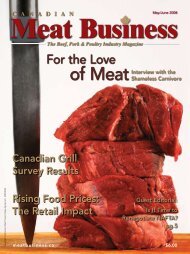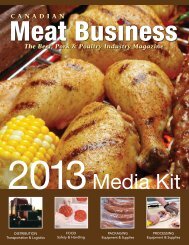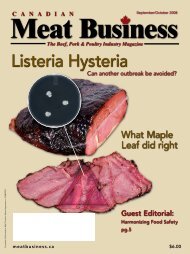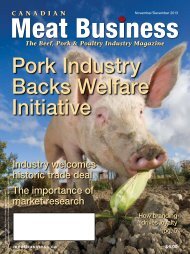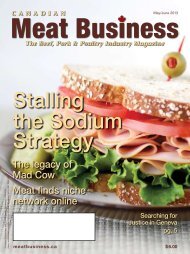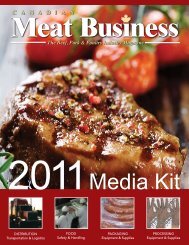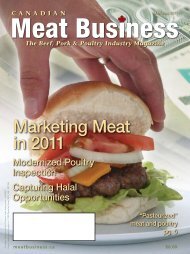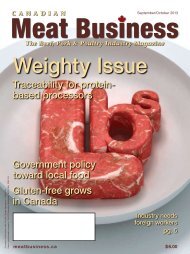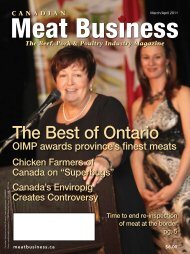Ralph Cator
Joining Meat Hall's Class of 2010 - Canadian Meat Business
Joining Meat Hall's Class of 2010 - Canadian Meat Business
You also want an ePaper? Increase the reach of your titles
YUMPU automatically turns print PDFs into web optimized ePapers that Google loves.
| Industr y Roundup |<br />
Inventories of major livestock on Canadian<br />
farms declined over last year<br />
Cattle and hog inventories in Canada declined between July<br />
1, 2009 and July 1, 2010, according to a report from Statistics<br />
Canada.<br />
The Canadian cattle herd fell by 4.9 per cent to 14.0 million<br />
and has been in a steady decline since its peak of 16.9 million<br />
in 2005, the agency reported. The hog inventory fell 2.4 per<br />
cent to 11.8 million.<br />
As of July 1, 99,026 farms reported beef or dairy cattle,<br />
down 3.5 per cent from the same date in 2009.<br />
During this period, the Canadian dairy herd fell 1.3 per<br />
cent, while the total beef herd declined 5.5 per cent. Statistics<br />
Canada said indications are that the beef herd is not rebuilding,<br />
as farmers reported a 5.1 per cent decline in the total number<br />
of beef cows and a 2.3 per cent drop in replacement heifers.<br />
The total number of dairy cows and replacement dairy heifers<br />
also declined compared with 2009.<br />
From January to July 2010, an estimated 1.9 million head of<br />
Canadian cattle and calves were sent to slaughter – a 6.5 per<br />
cent increase from the same period in 2009, but 0.3 per cent<br />
below levels reported for the July to December 2009 period.<br />
During the first six months of 2010, exports of live cattle and<br />
calves totalled 613,100 head, up 1.5 per cent from the same<br />
period in 2009.<br />
As of July 1, there were 7,050 hog farms in Canada, down<br />
10.6 per cent from the same date in 2009. Canadian hog<br />
producers reported an estimated 11.8 million hogs on their<br />
farms, down from 12.1 million hogs on the same date in<br />
2009.<br />
Farmers reported 1.3 million sows and gilts on their farms,<br />
down 4.8 per cent from July 1, 2009, and 9.4 per cent below<br />
levels as of July 1, 2008.<br />
Hogs that were sent to slaughter totalled 5.1 million during<br />
the second quarter, down 0.8 per cent from the same period<br />
in 2009. Canadian hog slaughter peaked in the fourth quarter<br />
of 2004 at just over 6.0 million head.<br />
During the second quarter, total hog exports amounted to<br />
1.4 million head, down 14.1 per cent from the same quarter<br />
in 2009. Second-quarter exports were 52.3 per cent below<br />
the peak of 2.9 million head recorded in the first quarter of<br />
2008.<br />
The number of sheep on Canadian farms also decreased, by<br />
1.9 per cent to 1.0 million head, the agency reported.<br />
Regionally, inventory levels of sheep fell across the country<br />
between July 1, 2009, and July 1, 2010, except in Alberta, the<br />
Atlantic region and Saskatchewan. The largest relative decline<br />
occurred in Manitoba, where the inventory declined 11.3 per<br />
cent.<br />
During the first six months of 2010, 325,900 sheep were<br />
sent to slaughter in Canada, down 4.5 per cent from the same<br />
period in 2009. Statistics Canada said the export market for<br />
sheep has remained virtually non-existent since 2003.<br />
Mexican market reopens for poultry<br />
genetics exporters<br />
Canadian poultry genetics exporters will again have access<br />
to the lucrative Mexican market since the doors were closed<br />
following the March 2004 outbreak of avian influenza,<br />
Agriculture and Agri-Food Canada (AAFC) announced.<br />
Imports of day old chicks and poults and hatching eggs to<br />
Mexico from all countries reached $18.2 million in 2009. Due<br />
to this new agreement, AAFC estimates that exports of these<br />
products from Canada could reach $2 million annually.<br />
“We’re very pleased to hear that the export of hatching<br />
eggs, day-old chicks and turkey poults from Canada to Mexico<br />
can restart after Canada received confirmation that Mexican<br />
authorities informed their border points of entry,” Agriculture<br />
Minister Gerry Ritz said in a release. “This is great news for<br />
farmers.”<br />
In 2009, Canadian agri-food exports to Mexico were $1.5<br />
billion.<br />
Government secures new market access to<br />
the Philippines<br />
Canadian exporters of rendered animal products have<br />
gained important access to Philippine markets that were<br />
previously closed to them, Agriculture Minister Gerry Ritz<br />
recently announced.<br />
Following a concerted effort by government and industry,<br />
the Philippine government has agreed to open its market to<br />
Canadian rendered animal by-products including blood meal,<br />
poultry meal and fats.<br />
The Canada Beef Export Federation estimates that the<br />
Philippine market for Canadian exporters of rendered<br />
products could reach $20 million.<br />
Last year, existing Canadian agri-food exports to the<br />
Philippines totalled $250 million.<br />
New E. coli test unveiled at IAFP<br />
California-based Life Technologies announced at the<br />
International Association of Food Protection (IAFP) annual<br />
meeting the launch of the MicroSEQ E. coli O157:H7 assay,<br />
designed to detect the deadly strain of E. coli using the<br />
company’s real-time PCR technology.<br />
According to the company the test has secured Performance<br />
Tested Methods certification from the AOAC Research<br />
Institute for detection of E. coli O157:H7. The new product<br />
will enable more effective monitoring of the food supply for<br />
contamination and help ensure food safety.<br />
E. coli O157:H7 can cause severe illness, even death and has<br />
been responsible for significant outbreaks of food poisoning<br />
across the globe, the company said in a release.<br />
Usually culture-based assays can take up to five days to yield<br />
results, but this new test is highly specific and sensitive and can<br />
be run in as little as eight hours, Life Technologies noted.<br />
Maple Leaf sees profit drop in Q2<br />
Maple Leaf Foods’ profits saw a decrease in the second<br />
quarter of 2010 due to a change in long-term interest rate<br />
swaps, but the company said it was pleased with its overall<br />
performance, particularly in its meat products division.<br />
In its Q2 report released at the end of July, Maple Leaf<br />
Foods reported net earnings of $3.0 million compared to<br />
$4.9 million last year. This includes a non-cash pre-tax charge<br />
of $20.7 million due to the change in fair value of long-term<br />
interest rate swaps.<br />
“We are very pleased with the continued steady improvements<br />
across our business in spite of challenging market conditions.”<br />
Maple Leaf president and CEO Michael H. McCain said in a<br />
release. “The protein business saw healthy improvements in<br />
financial performance while facing significant raw material<br />
28 Canadian Meat Business September/October 2010 meatbusiness.ca



